C++核心编程
本内容主要针对C++面向对象编程技术做详细讲解
1 内存分区模型
C++程序在执行时,将内存大方向划分为4个区域:
- 代码区:存放函数体的二进制代码,由操作系统进行管理
- 全局区:存放全局变量和静态变量以及常量
- 栈区:由编译器自动分配释放,存放函数的参数值,局部变量等
- 堆区:由程序员分配和释放,若程序员不释放,程序结束时由操作系统回收
内存四区意义:不同区域存放的数据,赋予不同的生命周期,给我们更大的灵活编程
1.1 程序运行前
在程序编译后,生成了exe可执行程序,未执行该程序前分为两个区域:
代码区:
-
存放 CPU 执行的机器指令
-
代码区是共享的,共享的目的是对于频繁被执行的程序,只需要在内存中有一份代码即可
-
代码区是只读的,使其只读的原因是防止程序意外地修改了它的指令
全局区:
- 全局变量和静态变量存放在此
- 全局区还包含了常量区,字符串常量和其他常量也存放在此
- 该区域的数据在程序结束后由操作系统释放
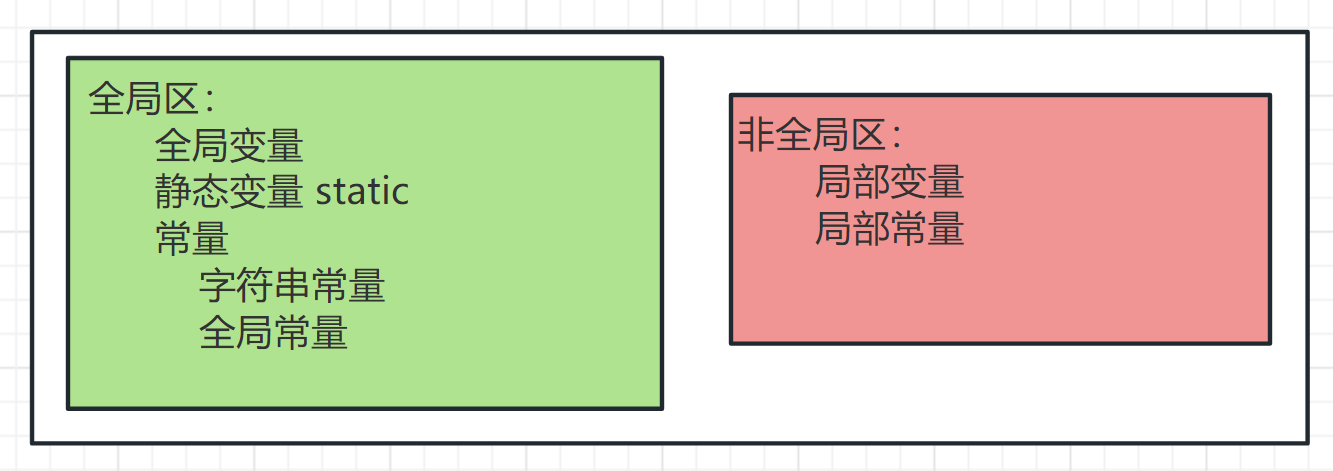
示例:
// 全局变量
int g_a = 10;
int g_b = 10;
// const修饰的全局变量,全局常量
const int c_g_a = 10;
int main() {
// 局部变量
int a = 10;
int b = 10;
cout << "局部变量a地址为:" << (int)&a << endl;
cout << "局部变量b地址为:" << (int)&b << endl;
cout << "全局变量g_a地址为:" << (int)&g_a << endl;
cout << "全局变量g_b地址为:" << (int)&g_b << endl;
// 静态变量
static int s_a = 10;
static int s_b = 10;
cout << "静态变量s_a地址为:" << (int)&s_a << endl;
cout << "静态变量s_b地址为:" << (int)&s_b << endl;
// 字符串常量
cout << "字符串常量的地址为:" << (int)&"hello, world" << endl;
// 常量
// const修饰的全局变量,const修饰的局部变量
cout << "全局常量c_g_a的地址为:" << (int)&c_g_a << endl;
const int c_l_a = 10;
cout << "局部常量c_l_a的地址为:" << (int)&c_l_a << endl;
system("pause");
return 0;
}
1.2 程序运行后
栈区:
- 由编译器自动分配释放,存放函数的参数值,局部变量等
- 注意事项:不要返回局部变量的地址,栈区开辟的数据由编译器自动释放
示例:
int * func() {
int a = 10;
return &a;
}
int main() {
int * p = func();
cout << *p << endl; // 第一次还可以打印正确的数字是因为编译器做了一次保留
cout << *p << endl; // 第二次这个数据就不再保留了
system("pause");
return 0;
}
堆区:
- 由程序员分配释放,若程序员不释放,程序结束时由操作系统回收
- 在C++中主要利用
new在堆区开辟内存,new返回创建数据的堆区地址
示例:
int * func() {
// 利用new关键字,可以将数据开辟到堆区
int * p = new int(10);
return p;
}
int main() {
int * p = func();
cout << *p << endl;
cout << *p << endl;
system("pause");
return 0;
}
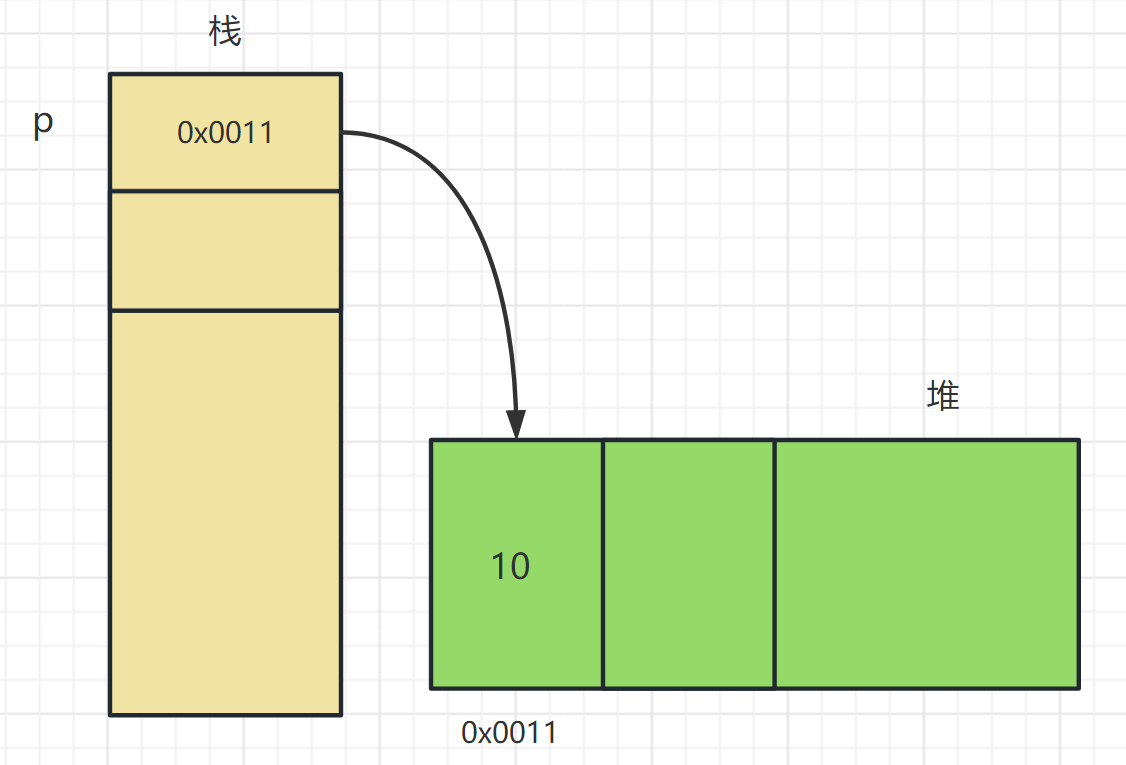
1.3 new操作符
C++中利用 new 操作符在堆区开辟数据
堆区开辟的数据,由程序员手动开辟,手动释放,释放利用操作符 delete,释放数组时要 delete[]
语法:new 数据类型
利用 new 创建的数据,会返回该数据对应的类型的指针
示例1:
void test01() {
int * p = new int(10);
cout << *p << endl;
cout << *p << endl;
cout << *p << endl;
delete p;
cout << *p << endl; // 内存已经被释放,再次访问就是非法操作,会报错
}
// 在堆区创建数组
void test02() {
int * arr = new int[10];
for (int i = 0; i < 10; i++) {
arr[i] = i + 100; // 给10个元素赋值 100~109
}
for (int i = 0; i < 10; i++) {
cout << arr[i] << endl;
}
// 释放堆区数组
delete[] arr;
}
int main() {
test01();
test02();
system("pause");
return 0;
}
2 引用
2.1 引用的基本使用
作用:给变量起别名
语法:数据类型 &别名 = 原名;
示例:
int main() {
int a = 10;
int &b = a;
cout << "a= " << a << endl;
cout << "b= " << b << endl;
b = 100;
cout << "a= " << a << endl;
cout << "b= " << b << endl;
system("pause");
return 0;
}
2.2 引用注意事项
- 引用必须初始化
- 引用在初始化后,不可以改变
2.3 引用做函数参数
作用:函数传参时,可以利用引用的技术让形参修饰实参
优点:可以简化指针修饰实参
示例:
// 引用传递
void mySwap(int &a, int &b) {
int temp = a;
a = b;
b = temp;
}
int main() {
int a = 10;
int b = 20;
mySwap(a, b);
cout << "a= " << a << endl;
cout << "b= " << b << endl;
system("pause");
return 0;
}
结论:通过引用参数产生的效果同按地址传递是一样的,引用的语法更简单清除。
2.4 引用做函数返回值
作用:引用是可以作为函数的返回值存在的
注意:不要返回局部变量引用
用法:函数调用作为左值
示例:
int & test() {
static int a = 10;
return a;
}
int main() {
int &ref = test();
cout << "ref= " << ref << endl;
cout << "ref= " << ref << endl;
ref = 1000;
cout << "ref= " << ref << endl;
cout << "ref= " << ref << endl;
system("pause");
return 0;
}
2.5 引用的本质
本质:引用的本质在C++内部实现是一个指针常量。
示例:
void func(int & ref) {
ref = 100;
}
int main() {
int a = 10;
// 自动转化为 int * const ref = &a;
// 指针常量是指指针指向不可改,也说明为什么引用不可更改
int & ref = a;
ref = 20; // 内部发现ref是引用,自动帮我们转换为:*ref = 20;
cout<< "a: " << a << endl;
cout<< "ref: " << ref << endl;
func(a);
return 0;
}
结论:C++推荐用引用技术,因为语法方便,引用本质是指针常量,但是所有的指针操作编译器都帮我们做了。
2.6 常量引用
作用:常量引用主要用来修饰形参,防止误操作
在函数形参列表中,可以加 const 修饰形参,防止形参改变实参
相当于 const int * const p = &a;
示例:
void showValue(const int & val) {
//val = 1000; // 报错,不能修改
cout << "val= " << val << endl;
}
int main() {
int a = 10;
showValue(a);
cout << "a= " << a << endl;
system("pause");
return 0;
}
3 函数提高
3.1 函数默认参数
在C++中,函数的形参列表中的形参是可以有默认值的
语法:返回值类型 函数名(参数=默认值) {...}
示例:
int func(int a, int b = 20, int c = 30) {
return a + b + c;
}
int main() {
cout << "sum= " << func(10) << endl;
system("pause");
return 0;
}
注意事项:
-
如果某个位置已经有了默认参数,那么往后所有参数都必须有默认值
-
如果函数声明有了默认参数,那么函数的实现就不能有默认参数
int func(int a, int b = 20, int c = 30); int func(int a, int b = 20, int c = 30) { // 报错,重定义默认参数 return a + b + c; }
3.2 函数占位参数
C++中函数的形参列表里可以有占位参数,用来做占位,调用函数时必须填补该位置
语法:返回值类型 函数名(数据类型) {...}
示例:
void func(int a, int) {
cout << "this is func" << endl;
}
int main() {
func(10, 10);
system("pause");
return 0;
}
占位参数也可以有默认参数
void func(int a, int = 10) {
cout << "this is func" << endl;
}
int main() {
func(10);
system("pause");
return 0;
}
3.3 函数重载
3.3.1 函数重载概述
作用:函数名可以相同,提高复用性
函数重载满足条件:
- 同一个作用域下
- 函数名相同
- 函数参数类型不同 或者 个数不同 或者 顺序不同
注意:函数返回值不可以作为函数重载的条件
3.3.2 函数重载注意事项
-
引用作为重载条件
-
函数重载碰到函数默认参数
注意防止二义性!例如:
int value = 1;
int &refvalue = value;
func(value);
func(refvalue);
此时,编译器的错误提示信息为:错误,有多个重载函数“func”实例与参数列表匹配
因为编译器无法区别实参value 或者 refvalue 到底是 int 类型还是 int 类型的引用。
示例:
// 1.引用作为重载的条件
void func(int &a) { // int &a = 10; 不合法
cout << "func(int &a) 调用" << endl;
}
void func(const int &a) { // const int &a = 10; 合法
cout << "const func(int &a) 调用" << endl;
}
// 2.函数重载碰到默认参数
void func2(int a, int b = 10) {
cout << "func2(int a, int b) 调用" << endl;
}
void func2(int a) {
cout << "func2(int a) 调用" << endl;
}
int main() {
int a = 10;
func(a);
func(10);
// func2(10); // 报错,出现二义性
system("pause");
return 0;
}
4 类和对象
C++面向对象三大特征:封装、继承、多态
C++认为万事万物皆为对象,对象有其属性和行为
4.1 封装
4.1.1 封装的意义:
- 将属性和行为作为一个整体,表现生活中的事物
- 将属性和行为加以权限控制
封装意义一:
在设计类的时候,属性和行为写在一起,表现事物
语法:
class 类名{
访问权限:
属性/行为
}
示例:设计一个圆类,求圆的周长
const double PI = 3.14;
class Circle {
//访问权限
public:
// 属性
int m_r;
// 行为
// 获取周长
double calculateZC() {
return 2 * PI * m_r;
}
};
int main() {
// 通过圆类创建一个具体对象
Circle c1;
// 给圆对象的属性赋值
c1.m_r = 10;
cout << "圆的周长为:" << c1.calculateZC() << endl;
system("pause");
return 0;
}
封装意义二:
类在设计时,可以把属性和行为放在不同的权限下,加以控制
访问权限有三种:
- public:公共权限,类内可以访问,类外可以访问
- protected:保护权限,类内可以访问,类外不可以访问,子类可以访问父类保护内容
- private:私有权限,类内可以访问,类外不可以访问,子类不能访问父类私有内容
示例:
class Person {
public:
string m_Name;
protected:
string m_Car;
private:
int m_Password;
public:
void func() {
m_Name = "张三";
m_Car = "拖拉机";
m_Password = 123456;
}
};
int main() {
Person p1;
p1.m_Name = "李四";
// p1.m_Car = "奔驰"; // 报错
system("pause");
return 0;
}
4.1.2 struct 和 class区别
在C++中 struct 和 class 唯一的区别就在于 默认的访问权限不同
区别:
struct默认权限为公共class默认权限为私有
示例:
class C1 {
int m_A;
};
struct C2 {
int m_B;
};
int main() {
C1 c1;
C2 c2;
// c1.m_A = 10; //报错,类外不能访问
c2.m_B = 10;
system("pause");
return 0;
}
4.1.3 成员属性设置为私有
优点:
- 将所有成员属性设置为私有,可以自己控制读写权限
- 对于写权限,我们可以检测数据的有效性
示例:
class Person {
private:
string m_Name; //可读可写
int m_Age; //只读
string m_Lover; //只写
public:
//写姓名
void setName(string name) {
m_Name = name;
}
//读姓名
string getName() {
return m_Name;
}
//获取年龄
int getAge() {
m_Age = 0;
return m_Age;
}
//修改年龄(年龄范围必须是0~150之间)
void setAge(int age) {
if (age < 0 || age > 150) {
m_Age = 0;
cout << "年龄输入有误!" << endl;
return;
}
m_Age = age;
}
// 写情人
void setLover(string lover) {
m_Lover = lover;
}
};
int main() {
Person p;
p.setName("张三");
cout << "姓名为:" << p.getName() << endl;
p.setAge(1000);
cout << "年龄为:" << p.getAge() << endl;
p.setLover("胖姐");
system("pause");
return 0;
}
4.2 对象的初始化和清理
4.2.1 构造函数和析构函数
对象的初始化和清理也是两个非常重要的安全问题
一个对象或者变量没有初始状态,对其使用后果是未知
同样的使用完一个对象或变量,没有及时清理,也会造成一定的安全问题
C++利用了 构造函数 和 析构函数 解决上述问题,这两个函数将会被编译器自动调用,完成对象初始化和清理工作。
对象的初始化和清理工作是编译器强制我们做的事情,因此如果我们不提供构造函数和析构函数,编译器会提供,但其提供的构造函数和析构函数是空实现。
- 构造函数:主要作用在于创建对象时为对象的成员属性赋值,构造函数由编译器自动调用,无需手动调用
- 析构函数:主要作用在于对象销毁前系统自动调用,执行一些清理工作
构造函数语法:类名() {...}
- 构造函数,没有返回值也不写
void - 函数名称与类名相同
- 构造函数可以有参数,因此可以发生重载
- 程序在调用对象时候会自动调用构造函数,无须手动调用,而且只会调用一次
析构函数语法:~类名() {...}
- 析构函数,没有返回值也不写
void - 函数名称与类名相同,在名称前加上符号
~ - 析构函数不可以有参数,因此不可以发生重载
- 程序在对象销毁前会自动调用析构函数,无须手动调用,而且只会调用一次
示例:
class Person {
public:
Person() {
cout << "Person构造函数的调用" << endl;
}
~Person() {
cout << "Person析构函数的调用" << endl;
}
};
void test() {
Person p;
}
int main() {
test(); //调用构造函数和析构函数
Person p; //调用构造函数
system("pause");
return 0;
}
4.2.2 构造函数的分类及调用
两种分类方式:
- 按参数分:有参构造和无参构造
- 按类型分:普通构造和拷贝构造
拷贝构造语法:Person(const Person &p) {...}
三种调用方式:
-
括号法
注意事项:调用默认构造函数时,不要加(),否则编译器会认为是函数的声明,不会认为在创建对象Person p(); //不会调用构造函数 -
显示法
注意事项:Person(10)是匿名对象,当前行执行结束后,系统会立即回收掉匿名对象- 不要利用拷贝构造函数初始化匿名对象,即
Person(p1);,编译器会认为Person(p1)等价于Person p1,编译器认为是对象声明,此时p1重定义
-
隐式转换法
示例:
class Person {
public:
Person() {
cout << "Person无参构造(默认构造)函数的调用" << endl;
}
Person(int a) {
m_Age = a;
cout << "Person有参构造函数的调用" << endl;
}
//拷贝构造函数
Person(const Person &p) {
m_Age = p.m_Age;
cout << "Person拷贝构造函数" << endl;
}
~Person() {
cout << "Person析构函数的调用" << endl;
}
int m_Age;
};
//调用
void test() {
//1、括号法
Person p1; //默认构造函数
Person p2(10); //有参构造
Person p3(p2); //拷贝构造函数
//2、显示法
Person p4;
Person p5 = Person(10);
Person p6 = Person(p5);
//3、隐式转换法
Person p7 = 10; //相当于写了 Person p7 = Person(10);
Person p8 = p7;
}
int main() {
test(); //调用构造函数和析构函数
system("pause");
return 0;
}
4.2.3 拷贝构造函数调用时机
C++中拷贝构造函数调用时机通常有三种情况:
- 使用一个已经创建完毕的对象来初始化一个新对象
- 值传递的方式给函数参数传值
- 以值方式返回局部对象
示例:
class Person {
public:
Person() {
cout << "Person无参构造函数调用" << endl;
}
Person(int age) {
m_Age = age;
cout << "Person有参构造函数调用" << endl;
}
Person(const Person &p) {
m_Age = p.m_Age;
cout << "Person拷贝构造函数调用" << endl;
}
~Person() {
cout << "Person析构函数的调用" << endl;
}
int m_Age;
};
//1、使用一个已经创建完毕的对象来初始化一个新对象
void test01() {
Person p1(20);
Person p2(p1);
cout << "p2年龄:" << p2.m_Age << endl;
}
//2、值传递的方式给函数参数传值
void doWork(Person p) {
}
void test02() {
Person p;
doWork(p);
}
//3、以值方式返回局部对象
Person doWork2() {
Person p;
return p;
}
void test03() {
Person p = doWork2();
}
int main() {
test01();
test02();
test03();
system("pause");
return 0;
}
4.2.4 析构函数调用规则
默认情况下,C++编译器至少给一个类添加3个函数
- 默认构造函数(无参,函数体为空)
- 默认析构函数(无参,函数体为空)
- 默认拷贝构造函数,对属性进行值拷贝
构造函数调用规则如下:
- 如果用户定义有参构造函数,C++不在提供默认无参构造,但是会提供默认拷贝构造
- 如果用户定义拷贝构造函数,C++不会再提供其他构造函数
4.2.5 深拷贝与浅拷贝
浅拷贝:简单的赋值拷贝操作
深拷贝:在堆区重新申请空间,进行拷贝操作
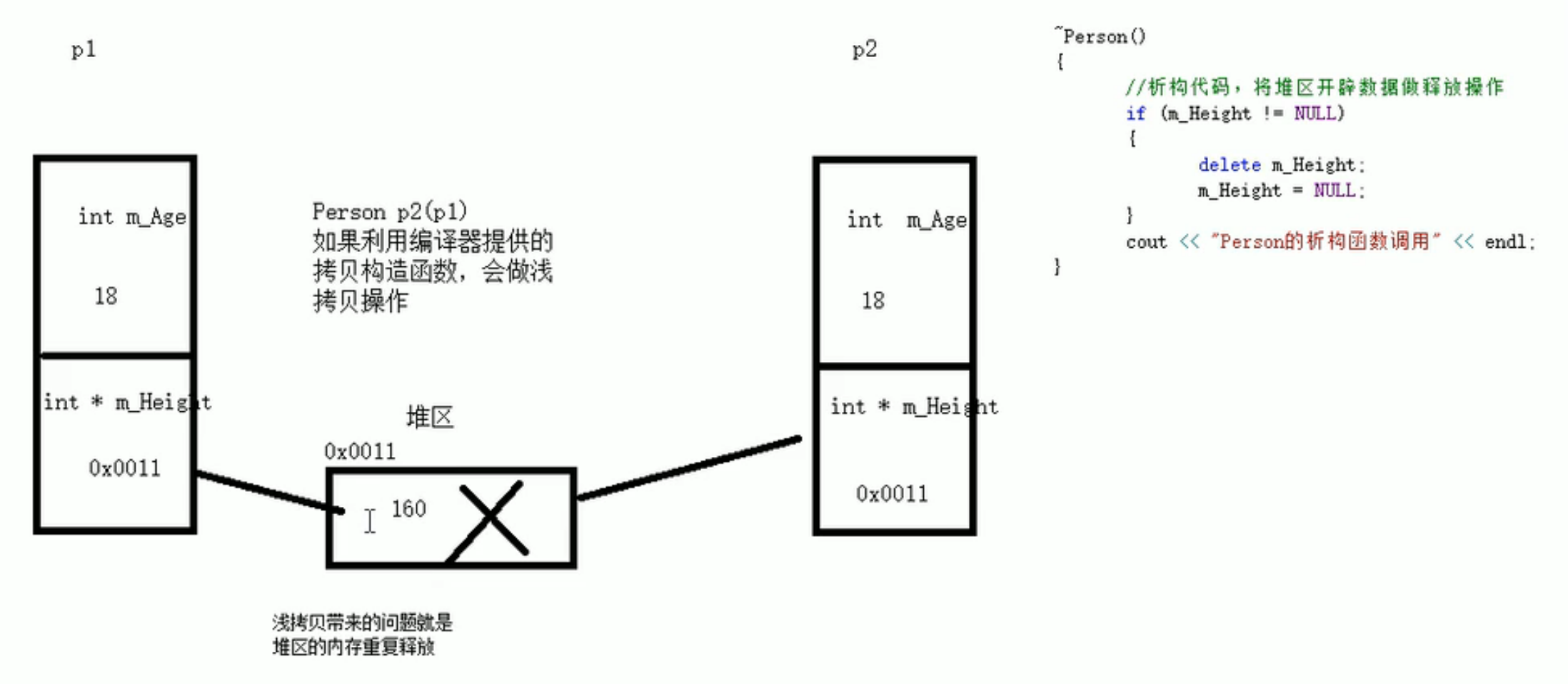
示例:
class Person {
public:
Person() {
cout << "Person无参构造函数调用" << endl;
}
Person(int age, int height) {
m_Age = age;
m_Height = new int(height);
cout << "Person有参构造函数调用" << endl;
}
// 自己实现拷贝构造函数,解决浅拷贝带来的问题
Person(const Person & p) {
m_Age = p.m_Age;
// 深拷贝操作
m_Height = new int(*p.m_Height);
cout << "Person拷贝构造函数调用" << endl;
}
~Person() {
// 将堆区开辟数据释放
if (m_Height != NULL) {
delete m_Height;
m_Height = NULL;
}
cout << "Person析构函数的调用" << endl;
}
int m_Age;
int * m_Height;
};
void test01() {
Person p1(20, 160);
cout << "p1年龄:" << p1.m_Age << " 身高为:" << *p1.m_Height << endl;
Person p2(p1);
cout << "p2年龄:" << p2.m_Age << " 身高为:" << *p2.m_Height << endl;
}
int main() {
test01();
system("pause");
return 0;
}
总结:如果属性有在堆区开辟,一定要自己提供拷贝构造函数,防止浅拷贝带来问题
4.2.6 初始化列表
作用:C++提供了初始化列表语法,用来初始化属性
语法:构造函数(): 属性1(值1), 属性2(值2),... {}
示例:
class Person {
public:
// 传统初始化操作
//Person(int a, int b, int c) {
// m_A = a;
// m_B = b;
// m_C = c;
//}
// 初始化列表
Person(int a, int b, int c) :m_A(a), m_B(b), m_C(c) {}
int m_A;
int m_B;
int m_C;
};
void test01() {
Person p(10, 20, 30);
cout << "m_A: " << p.m_A << endl;
cout << "m_B: " << p.m_B << endl;
cout << "m_C: " << p.m_C << endl;
}
int main() {
test01();
system("pause");
return 0;
}
4.2.7 类对象作为类成员
C++类中的成员可以是另一个类的对象,我们称该成员为 对象成员
例如:
class A {};
class B {
A a;
};
B类 中有对象A 作为成员,A为对象成员
那么当创建B对象时,A与B的构造函数和析构函数的顺序谁先谁后?
- 构造函数:先构造 A 再构造 B
- 析构函数:先析构 B 再析构 A
示例:
class Phone {
public:
Phone(string pName) {
m_PName = pName;
cout << "Phone构造函数调用" << endl;
}
~Phone() {
cout << "Phone析构函数调用" << endl;
}
string m_PName;
};
class Person {
public:
// Phone m_Phone = pName; 隐式转换法
Person(string name, string pName): m_Name(name), m_Phone(pName) {
cout << "Person构造函数调用" << endl;
}
~Person() {
cout << "Person析构函数调用" << endl;
}
string m_Name;
Phone m_Phone;
};
void test01() {
Person p("张三", "iphone");
cout << p.m_Name << " 拿着 " << p.m_Phone.m_PName << endl;
}
int main() {
test01();
system("pause");
return 0;
}
4.2.8 静态成员
静态成员就是在成员变量和成员函数前加上关键字 static ,称为静态成员
静态成员分为:
- 静态成员变量
- 所有对象共享同一份数据
- 在编译阶段分配内存
- 类内声明,类外初始化
- 静态成员函数
- 所有对象共享同一个函数
- 静态成员函数只能访问静态成员变量
示例1:静态成员变量
class Person {
public:
static int m_A;
private:
static int m_B;
};
int Person::m_A = 100;
int Person::m_B = 200;
void test01() {
Person p;
cout << p.m_A << endl;
Person p2;
p2.m_A = 200;
cout << p.m_A << endl;
}
void test02() {
//静态成员变量两种访问方式
//1、通过对象访问
Person p;
cout << p.m_A << endl;
//2、通过类名访问
cout << Person::m_A << endl;
//cout << Person::m_B << endl; //错误,类外访问不到私有静态成员变量
}
int main() {
test01();
test02();
system("pause");
return 0;
}
示例2:静态成员函数
class Person {
public:
static void func() {
m_A = 100;
//m_B = 200; //错误,静态成员函数不能访问非静态成员变量
cout << "static void func() 调用" << endl;
}
static int m_A;
int m_B;
};
int Person::m_A = 0;
void test01() {
//静态成员函数两种访问方式
//1、通过对象访问
Person p;
p.func();
//2、通过类名访问
Person::func();
}
int main() {
test01();
system("pause");
return 0;
}
4.3 C++对象模型和this指针
4.3.1 成员变量和成员函数分开存储
在C++中,类内的成员变量和成员函数分开存储
只有非静态成员变量才属于类的对象上,静态成员变量,非静态成员函数以及静态成员函数 都不属于类的对象
示例:
class Person {
int m_A; //非静态成员变量 属于类的对象上
static int m_B; //静态成员变量 不属于类的对象上
void func() {} //非静态成员函数 不属于类的对象上
static void func2() {} //静态成员函数 不属于类的对象上
};
int Person::m_B = 1;
void test01() {
Person p;
//空对象占用空间 1 字节
//C++编译器会给每个空对象也分配一个字节空间,是为了区分空对象占内存的位置
//每个空对象也应该有一个独一无二的内存地址
cout << "sizeof(p)= " << sizeof(p) << endl;
}
void test02() {
Person p;
cout << "sizeof(p)= " << sizeof(p) << endl;
}
int main() {
//test01();
test02();
system("pause");
return 0;
}
4.3.2 this指针
每一个非静态成员函数只会诞生一份函数实例,也就是说多个同类型的对象会共用一块代码
那么问题是:这一块代码是如何区分哪个对象调用自己的呢?
C++通过提供特殊的对象指针,this 指针解决上述问题。this指针指向被调用的成员函数所属的对象
this 指针是隐含每一个非静态成员函数内的一种指针
this 指针不需要定义,直接使用即可
this 指针的用途:
- 当形参和成员变量同名时,可用
this指针来区分 - 在类的非静态成员函数中返回对象分身,可使用
return *this;
示例:
class Person {
public:
Person(int age) {
this->age = age;
}
Person& PersonAddAge(Person &p) {
this->age += p.age;
//this指向p2的指针,而*this指向的就是p2本体
return *this;
}
int age;
};
void test01() {
Person p(18);
cout << "年龄: " << p.age << endl;
}
void test02() {
Person p1(18);
Person p2(10);
//链式编程思想
p2.PersonAddAge(p1).PersonAddAge(p1).PersonAddAge(p1);
cout << "年龄: " << p2.age << endl;
}
int main() {
//test01();
test02();
system("pause");
return 0;
}
4.3.3 空指针访问成员函数
C++中空指针也是可以调用成员函数的,但是也要注意有没有用到 this 指针
如果用到 this 指针,需要加以判断保证代码的健壮性
示例:
class Person {
public:
void showClassName() {
cout << "this is Person class" << endl;
}
void showPersonAge() {
//提高代码健壮性
if (this == NULL) {
return;
}
cout << "age = " << m_Age << endl;
}
int m_Age;
};
void test01() {
Person * p = NULL;
p->showClassName();
//p->showPersonAge(); //报错,this空指针没有属性
}
int main() {
test01();
system("pause");
return 0;
}
4.3.4 const修饰成员函数
常函数:
- 成员函数后加
const后我们称为这个函数为常函数 - 常函数内不可以修改成员属性,注意:常函数可以修改静态变量
- 成员属性声明时加关键字
mutable后,在常函数中依然可以修改
常对象:
- 声明对象前加
const称为该对象为常对象 - 常对象只能调用常函数,注意:常对象可以调用静态成员函数
示例:
class Person {
public:
// this指针的本质是指针常量,指针的指向是不可以修改的
// 相当于 const Person * const this;
// 在成员函数后面加 const,修饰的是this指针,让指针指向的值也不能修改
void showPerson() const{
m_B = 100;//mutable变量可以修改值
cout << "this is Person class" << endl;
}
void func() {}
int m_A;
mutable int m_B;
};
void test01() {
const Person p; //常对象
p.m_A = 100; //报错,不能修改
p.m_B = 100; //可以修改
p.showPerson();
p.func(); //报错,常对象只能调用常函数
}
int main() {
system("pause");
return 0;
}
4.4 友元
友元的目的就是让一个函数或者类 访问另一个类中私有成员
友元的关键字为 friend
友元的三种实现:
- 全局函数做友元
- 类做友元
- 成员函数做友元
4.4.1 全局函数做友元
class Building {
// goodGuy访问 Building中私有成员
friend void goodGuy(Building &building);
public:
Building() {
m_SittingRoom = "客厅";
m_BedRoom = "卧室";
}
public:
string m_SittingRoom;
private:
string m_BedRoom;
};
//全局函数
void goodGuy(Building &building) {
cout << "好朋友全局函数 正在访问:" << building.m_SittingRoom << endl;
cout << "好朋友全局函数 正在访问:" << building.m_BedRoom << endl;
}
void test01() {
Building building;
goodGuy(building);
}
int main() {
test01();
system("pause");
return 0;
}
4.4.2 类做友元
class Building;
class GoodGuy {
public:
GoodGuy();
void visit(); //访问Building中的属性
Building * building;
};
class Building {
// GoodGuy类是友元类,可以访问本类中私有成员
friend class GoodGuy;
public:
Building();
public:
string m_SittingRoom;
private:
string m_BedRoom;
};
//类外写成员函数
Building::Building() {
m_SittingRoom = "客厅";
m_BedRoom = "卧室";
}
GoodGuy::GoodGuy() {
building = new Building;
}
void GoodGuy::visit() {
cout << "GoodGuy 正在访问:" << building->m_SittingRoom << endl;
cout << "GoodGuy 正在访问:" << building->m_BedRoom << endl;
}
void test01() {
GoodGuy gg;
gg.visit();
}
int main() {
test01();
system("pause");
return 0;
}
4.4.3 成员函数做友元
class Building;
class GoodGuy {
public:
GoodGuy();
void visit1(); //可以访问Building中的私有成员
void visit2(); //不可以访问Building中的私有成员
Building * building;
};
class Building {
// GoodGuy类下的visit1()是友元函数,可以访问本类中私有成员
friend void GoodGuy::visit1();
public:
Building();
public:
string m_SittingRoom;
private:
string m_BedRoom;
};
//类外写成员函数
Building::Building() {
m_SittingRoom = "客厅";
m_BedRoom = "卧室";
}
GoodGuy::GoodGuy() {
building = new Building;
}
void GoodGuy::visit1() {
cout << "GoodGuy visit1 正在访问:" << building->m_SittingRoom << endl;
cout << "GoodGuy visit1 正在访问:" << building->m_BedRoom << endl;
}
void GoodGuy::visit2() {
cout << "GoodGuy visit2 正在访问:" << building->m_SittingRoom << endl;
//cout << "GoodGuy visit2 正在访问:" << building->m_BedRoom << endl; //报错,不能访问私有成员
}
void test01() {
GoodGuy gg;
gg.visit1();
gg.visit2();
}
int main() {
test01();
system("pause");
return 0;
}
4.5 运算符重载
运算符重载概念:对已有的运算符重新进行定义,赋予其另一种功能,以适应不同的数据类型
4.5.1 加号运算符重载
作用:实现两个自定义数据类型相加的运算
示例:
class Person {
public:
//1、成员函数重载+号
//Person operator+(Person &p) {
// Person temp;
// temp.m_A = this->m_A + p.m_A;
// temp.m_B = this->m_B + p.m_B;
// return temp;
//}
int m_A;
int m_B;
};
//2、全局函数重载+号
Person operator+(Person &p1, Person &p2) {
Person temp;
temp.m_A = p1.m_A + p2.m_A;
temp.m_B = p1.m_B + p2.m_B;
return temp;
}
// 函数重载版本
Person operator+(Person &p1, int num) {
Person temp;
temp.m_A = p1.m_A + num;
temp.m_B = p1.m_B + num;
return temp;
}
void test01() {
Person p1;
p1.m_A = 10;
p1.m_B = 10;
Person p2;
p2.m_A = 10;
p2.m_B = 10;
//成员函数重载本质调用:
//Person p3 = p1.operator+(p2);
//全局函数重载本质调用:
//Person p3 = operator+(p1, p2);
Person p3 = p1 + p2;
//运算符重载也能实现函数重载,例如
//Person p4 = p3 + 10;
cout << "m_A = " << p3.m_A << endl;
cout << "m_B = " << p3.m_B << endl;
}
int main() {
test01();
system("pause");
return 0;
}
总结:对于内置的数据类型的表达式的运算符是不可以改变的
4.5.2 左移运算符重载
作用:可以输出自定义数据类型
示例:
class Person {
friend ostream & operator<<(ostream &cout, Person &p);
public:
Person(int a, int b){
m_A = a;
m_B = b;
}
private:
//1、利用成员函数重载 左移运算符 p.operator<<(cout) 简化版本 p<<cout
//不会利用成员函数重载 <<运算符,因为无法实现 cout在左侧
//void operator<<(cout) {
//
//}
int m_A;
int m_B;
};
//2、全局函数重载 左移运算符
ostream & operator<<(ostream &cout, Person &p) { //本质 operator<<(cout, p),简化cout<<p
cout << "m_A= " << p.m_A << ", m_B= " << p.m_B;
return cout;
}
void test01() {
Person p(10, 10);
cout << p <<endl;
}
int main() {
test01();
system("pause");
return 0;
}
总结:重载左移运算符配合友元可以实现输出自定义数据类型
4.5.3 递增运算符重载
作用:通过重载递增运算符,实现自己的整型数据
class MyInteger {
//friend ostream & operator<<(ostream &cout, MyInteger &myInt);
friend ostream & operator<<(ostream &cout, MyInteger myInt);
public:
MyInteger() {
m_Num = 0;
}
// 重载前置++运算符
// 返回引用是为了一直对一个数据进行递增操作
MyInteger & operator++() {
m_Num ++;
return *this;
}
// 重载后置++运算符
// 这个int代表占位参数,用于区分前置和后置递增
MyInteger operator++(int) {
MyInteger temp = *this;
m_Num++;
return temp;
}
private:
int m_Num;
};
// 重载 左移运算符
//ostream & operator<<(ostream &cout, MyInteger & myint) { //本质 operator<<(cout, p),简化cout<<p
// cout << "myint= " << myint.m_Num;
// return cout;
//}
ostream & operator<<(ostream &cout, MyInteger myInt) {
cout << "myInt= " << myInt.m_Num;
return cout;
}
void test01() {
MyInteger myInt;
cout << ++(++myInt) << endl;
cout << myInt << endl;
}
void test02() {
MyInteger myInt;
cout << myInt++ << endl;
cout << myInt << endl;
}
int main() {
//test01();
test02();
system("pause");
return 0;
}
4.5.4 赋值运算符重载
C++编译器至少给一个类添加4个函数
- 默认构造函数(无参,函数体为空)
- 默认析构函数(无参,函数体为空)
- 默认拷贝构造函数,对属性进行值拷贝
- 赋值运算符
operator=,对属性进行值拷贝
如果类中有属性指向堆区,做赋值操作时也会出现深浅拷贝问题
示例:
class Person {
public:
Person(int age) {
m_Age = new int(age);
}
~Person() {
if (m_Age != NULL) {
delete m_Age;
m_Age = NULL;
}
}
// 重载赋值运算符
Person & operator=(Person & p) {
// 编译器是提供浅拷贝
// m_Age = p.m_Age;
// 应该先判断是否有属性在堆区,如果有先释放干净,然后再深拷贝
if (m_Age != NULL) {
delete m_Age;
m_Age = NULL;
}
// 深拷贝
m_Age = new int(*p.m_Age);
return *this;
}
int * m_Age;
};
void test01() {
Person p1(18);
Person p2(20);
Person p3(22);
p3 = p2 = p1;
cout << "p1的年龄为:" << *p1.m_Age << endl;
cout << "p2的年龄为:" << *p2.m_Age << endl;
cout << "p3的年龄为:" << *p3.m_Age << endl;
}
int main() {
test01();
system("pause");
return 0;
}
4.5.5 关系运算符重载
作用:重载关系运算符,可以让两个自定义类型对象进行对比操作
示例:
class Person {
public:
Person(string name, int age) {
m_Name = name;
m_Age = age;
}
// 重载关系运算符==
bool operator==(Person & p) {
if (this->m_Name == p.m_Name && this->m_Age == p.m_Age) {
return true;
}
return false;
}
string m_Name;
int m_Age;
};
void test01() {
Person p1("Tom", 18);
Person p2("Tom", 28);
if (p1 == p2) {
cout << "p1 和 p2 是相等的" << endl;
}
else {
cout << "p1 和 p2 是不相等的" << endl;
}
}
int main() {
test01();
system("pause");
return 0;
}
4.5.6 函数调用运算符重载
- 函数调用运算符
()也可以重载 - 由于重载后使用的方式非常像函数的调用,因此称为仿函数
- 仿函数没有固定写法,非常灵活
示例:
class MyPrint {
public:
//重载函数调用运算符
void operator()(string test) {
cout << test << endl;
}
};
void MyPrint02(string test) {
cout << test << endl;
}
void test01() {
MyPrint myPrint;
myPrint("hello, world");//由于使用起来非常类似函数调用,因此称为仿函数
MyPrint02("hello, world");
}
//仿函数非常灵活,没有固定的写法
//加法类
class MyAdd
{
public:
int operator()(int num1, int num2)
{
return num1 + num2;
}
};
void test02()
{
MyAdd myAdd;
int res = myAdd(100, 23);
cout << res << endl;
//匿名函数对象
cout << MyAdd()(100, 100) << endl;
}
int main() {
//test01();
test02();
system("pause");
return 0;
}
4.6 继承
4.6.1 继承的基本语法
语法:class 子类 : 继承方式 父类 {...}
示例:
class BasePage
{
public:
void header()
{
cout << "首页,公开课,登录,注册....(公共头部)" << endl;
}
void footer()
{
cout << "帮助中心,交流合作...(公共底部)" << endl;
}
void left()
{
cout << "Java,Python,C++...(公共分类列表)" << endl;
}
};
class Java : public BasePage
{
public:
void content()
{
cout << "Java学科视频" << endl;
}
};
class Python : public BasePage
{
public:
void content()
{
cout << "Python学科视频" << endl;
}
};
class Cpp : public BasePage
{
public:
void content()
{
cout << "C++学科视频" << endl;
}
};
void test01()
{
cout << "Java页面如下:" << endl;
Java ja;
ja.header();
ja.left();
ja.content();
ja.footer();
cout << "====================" << endl;
cout << "Python页面如下:" << endl;
Python py;
py.header();
py.left();
py.content();
py.footer();
cout << "====================" << endl;
cout << "C++页面如下:" << endl;
Cpp cpp;
cpp.header();
cpp.left();
cpp.content();
cpp.footer();
}
int main() {
test01();
system("pause");
return 0;
}
4.6.2 继承方式
继承方式一共有三种:
- 公共继承
- 保护继承
- 私有继承
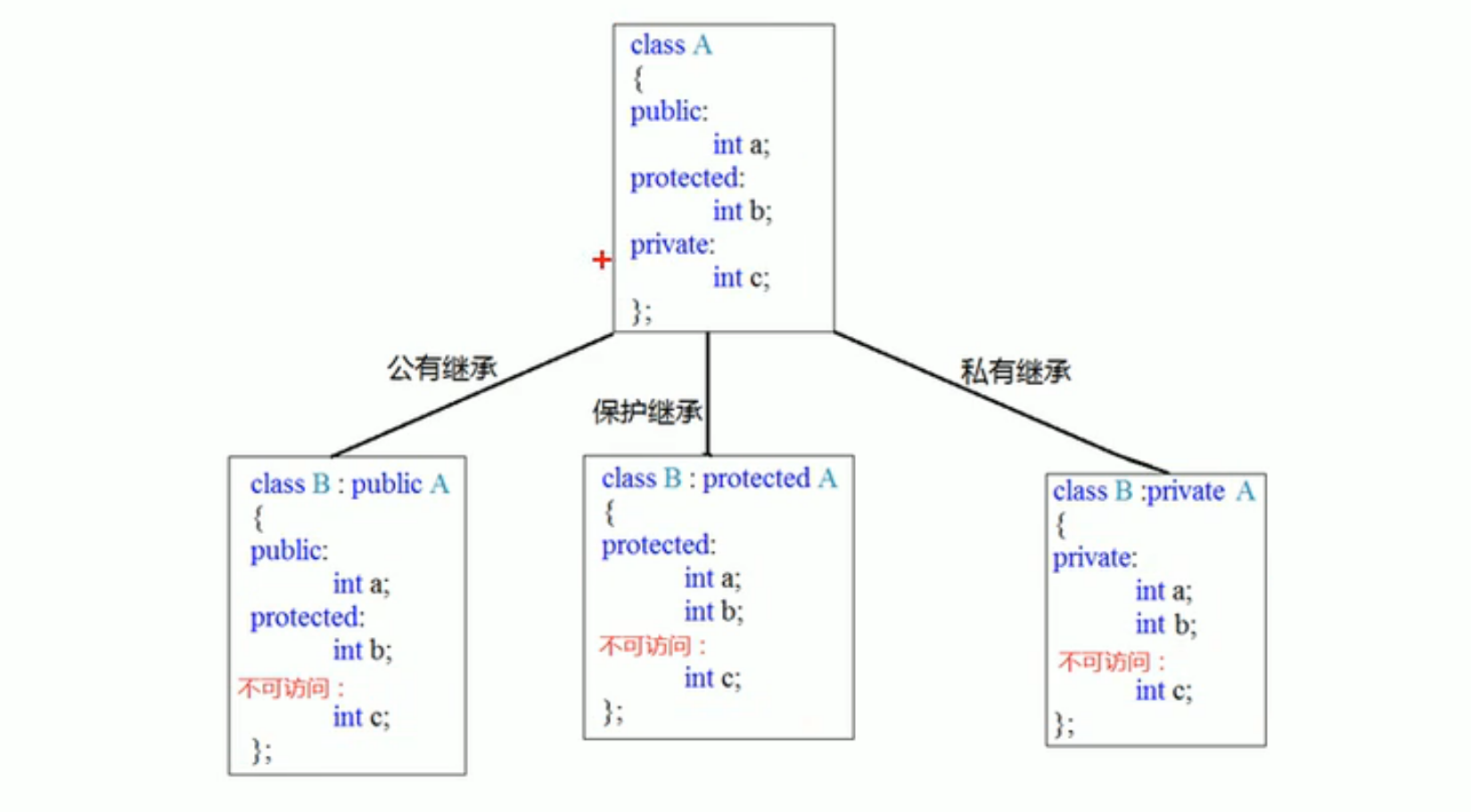
4.6.3 继承中的对象模型
问题:从父类继承过来的成员,哪些属于子类对象中?
查看对象模型:cl /d1 reportSingleClassLayoutSon 01.cpp
示例:
class Base
{
public:
int m_A;
protected:
int m_B;
private:
int m_C;
};
class Son : public Base
{
public:
int m_D;
};
void test01()
{
// 父类中所有的非静态成员都会被子类继承下去
// 父类中私有的成员属性被编译器隐藏,访问不到,但是被继承了
cout << "size of Son :" << sizeof(Son) << endl; //输出16
}
int main() {
test01();
system("pause");
return 0;
}
结论:父类中私有成员也是被子类继承下去了,只是由编译器给隐藏后访问不到
4.6.4 继承中构造和析构顺序
子类继承父类后,当创建子类对象,也会调用父类的构造函数
结论:父类构造 --> 子类构造 --> 子类析构 --> 父类析构
4.6.5 继承同名成员处理方式
问题:当子类与父类出现同名的成员,如何通过子类对象,访问到子类或者父类中同名的数据呢?
- 访问子类同名成员 直接访问即可
- 访问父类同名成员 需要加作用域
示例:
class Base
{
public:
Base()
{
m_A = 100;
}
void func()
{
cout << "Base-func() 调用" << endl;
}
void func(int a)
{
cout << "Base-func(int a) 调用" << endl;
}
int m_A;
};
class Son : public Base
{
public:
Son()
{
m_A = 200;
}
void func()
{
cout << "Son-func() 调用" << endl;
}
int m_A;
};
void test01()
{
Son s;
cout << "Son m_A = " << s.m_A << endl;
cout << "Base m_A = " << s.Base::m_A << endl;
}
void test02()
{
Son s;
s.func();
s.Base::func();
//如果子类中出现和父类同名的成员函数,子类的同名成员会隐藏掉父类中所有同名成员函数
//如果想访问到父类中被隐藏的同名成员函数,需要加作用域
s.Base::func(100);
}
int main() {
//test01();
test02();
system("pause");
return 0;
}
总结:
- 子类对象可以直接访问到子类中同名成员
- 子类对象加作用域可以访问到父类同名成员
- 当子类与父类拥有同名的成员函数,子类会隐藏父类中同名成员函数,加作用域可以访问到父类中同名函数
4.6.6 继承同名静态成员处理方式
问题:继承中同名的静态成员在子类对象上如何进行访问?
静态成员和非静态成员出现同名,处理方式一致
- 访问子类同名成员 直接访问即可
- 访问父类同名成员 需要加作用域
示例:
class Base
{
public:
static int m_A;
};
int Base::m_A = 100;
class Son : public Base
{
public:
static int m_A;
};
int Son::m_A = 200;
void test01()
{
//1、通过对象访问
cout << "通过对象访问:" << endl;
Son s;
cout << "Son下m_A= " << s.m_A << endl;
cout << "Base下m_A= " << s.Base::m_A << endl;
//2、通过类名访问
cout << "通过类名访问:" << endl;
cout << "Son下m_A = " << Son::m_A << endl;
//第一个::代表通过类名方式访问,第二个::代表访问父类作用域下的m_A
cout << "Base下m_A = " << Son::Base::m_A << endl;
}
int main() {
test01();
system("pause");
return 0;
}
结论:同名静态成员处理方式和非静态成员处理方式一样,只不过有两种访问的方式(通过对象 和 通过类名)
4.6.7 多继承语法
C++允许一个类继承多个类
语法:class 子类 : 继承方式 父类1, 继承方式 父类2, ...
多继承可能会引发父类中有同名成员出现,出现二义性问题,需要加作用域区分
C++实际开发中,不建议用多继承
4.6.8 菱形继承
菱形继承概念:两个派生类继承同一个基类,又有某个类同时继承这两个派生类,这种继承称为菱形继承或者钻石继承。
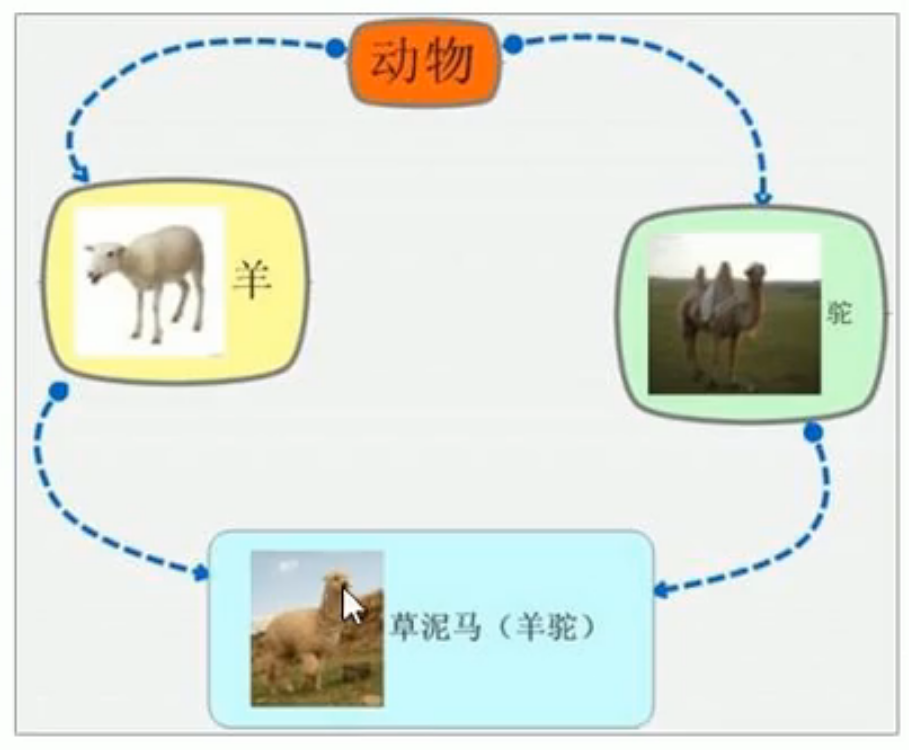
菱形继承问题:
- 羊继承了动物的数据,驼同样继承了动物的数据,当草泥马使用数据时,就会产生二义性
解决方案:加作用域进行区分 - 草泥马继承自动物的数据继承了两份,这份数据只需要一份就可以
解决方案:使用虚继承
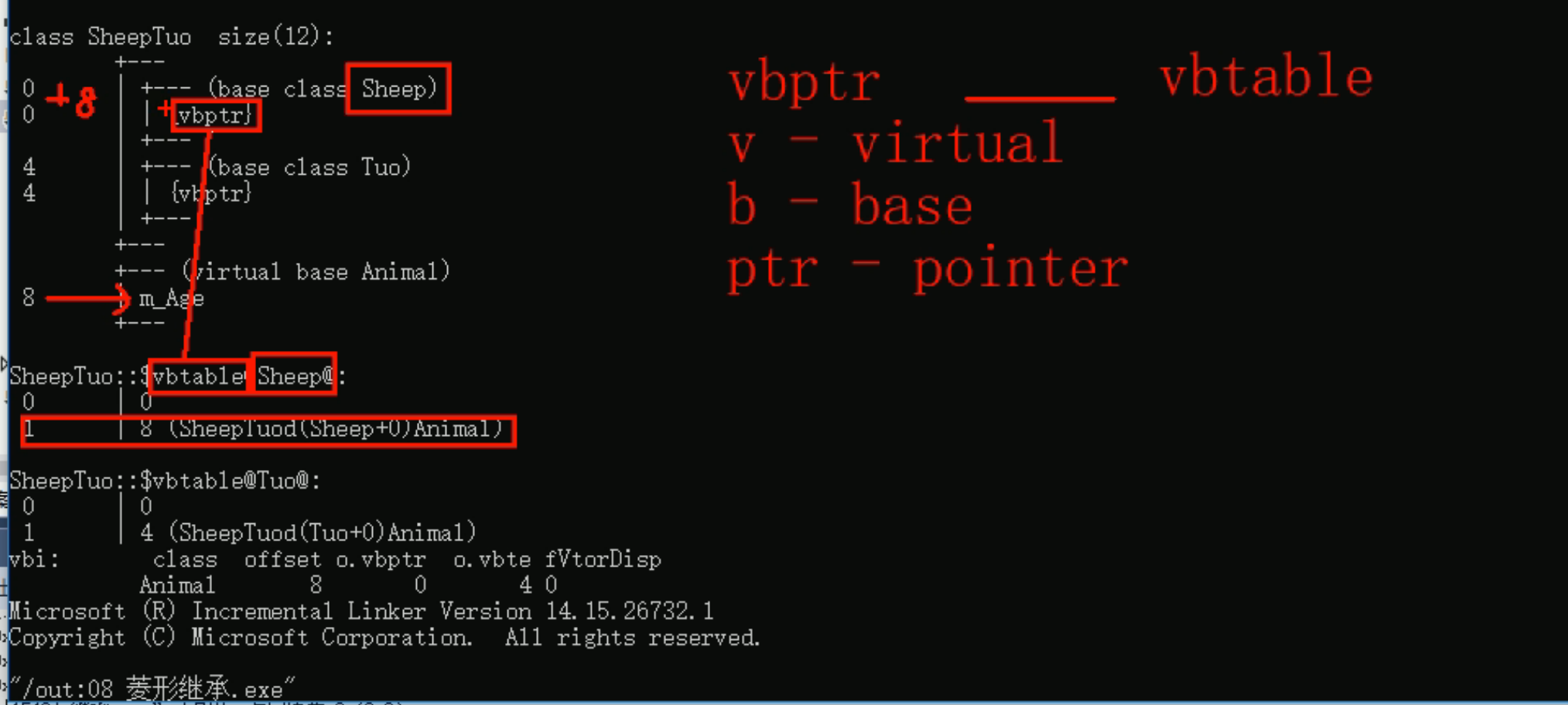
示例:
class Animal
{
public:
int m_Age;
};
// 利用虚继承解决菱形继承问题
// Animal类称为 虚基类
// 羊类
class Sheep : virtual public Animal {};
// 驼类
class Tuo : virtual public Animal {};
// 羊驼类
class SheepTuo : public Sheep, public Tuo {};
void test01()
{
SheepTuo st;
st.Sheep::m_Age = 18;
st.Tuo::m_Age = 28;
cout << "st.Sheep::m_Age = " << st.Sheep::m_Age << endl;
cout << "st.Tuo::m_Age = " << st.Tuo::m_Age << endl;
cout << "st.m_Age = " << st.m_Age << endl;
}
int main() {
test01();
system("pause");
return 0;
}
4.7 多态
4.7.1 多态的基本概念
多态分为两类:
-
静态多态:函数重载 和 运算符重载属于静态多态,复用函数名
-
动态多态:派生类和虚函数实现运行时多态
满足条件:- 有继承关系
- 子类重写父类虚函数
使用条件:父类的指针或者引用指向子类对象,例如:
void doSpeak(Animal & animal) // Animal & animal = cat; { ... }
静态多态和动态多态区别:
- 静态多态的函数地址早绑定 - 编译阶段确定函数地址
- 动态多态的函数地址晚绑定 - 运行阶段确定函数地址
示例:
class Animal
{
public:
virtual void speak()
{
cout << "动物在说话" << endl;
}
};
class Cat :public Animal
{
public:
void speak()
{
cout << "小猫在说话" << endl;
}
};
class Dog :public Animal
{
public:
void speak()
{
cout << "小狗在说话" << endl;
}
};
//地址早绑定 在编译阶段确定函数地址
//如果想执行让猫说话,那么这个函数地址就不能提前绑定,需要在运行阶段绑定,地址晚绑定 使用virtual
void doSpeak(Animal & animal)
{
animal.speak();
}
void test01()
{
Cat cat;
doSpeak(cat);
Dog dog;
doSpeak(dog);
}
int main() {
test01();
system("pause");
return 0;
}
4.7.2 多态的原理剖析
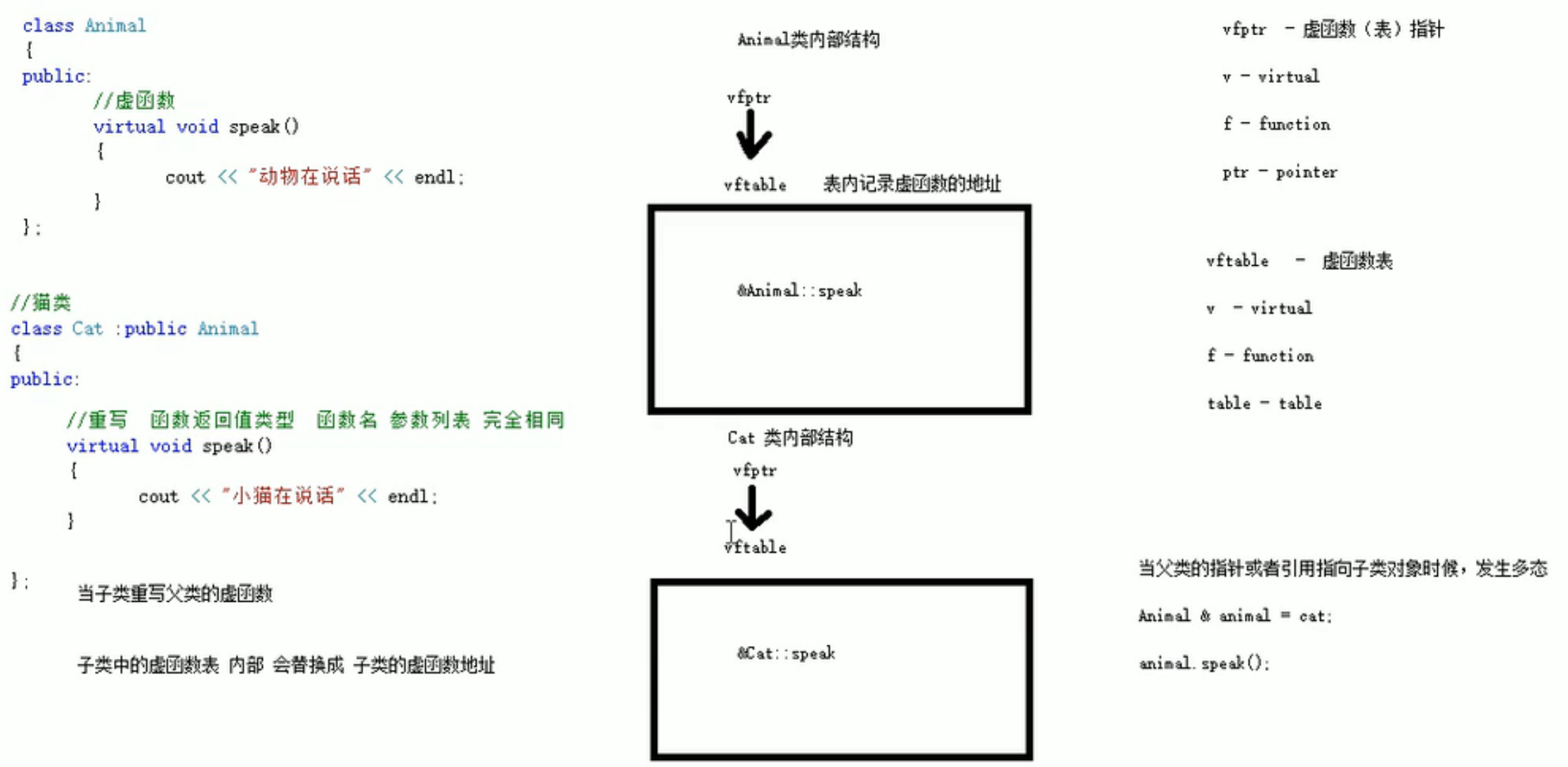
4.7.3 纯虚函数和抽象类
在多态中,通常父类中虚函数的实现是毫无意义的,主要都是调用子类重写的内容,因此可以将虚函数改为纯虚函数。
语法:virtual 返回值类型 函数名(参数列表) = 0;
当类中有了纯虚函数,这个类也称为 抽象类
抽象类特点:
- 无法实例化对象
- 子类必须重写抽象类中的纯虚函数,否则也属于抽象类
示例:
class Base
{
public:
//纯虚函数
virtual void func() = 0;
int m_A = 100;
};
class Son :public Base
{
public:
//子类重写父类虚函数
virtual void func()
{
cout << "func() 调用" << endl;
}
};
void test01()
{
Son s;
s.func();
}
int main() {
test01();
system("pause");
return 0;
}
4.7.4 虚析构和纯虚析构
多态使用时,如果子类中有属性开辟到堆区,那么父类指针在释放时无法调用到子类的析构函数
解决方式:将父类中的析构函数改为 虚析构 或者 纯虚析构
虚析构和纯虚析构共性:
- 可以解决父类指针释放子类对象
- 都需要有具体的函数实现
虚析构和纯虚析构区别:
- 如果是纯虚析构,该类属于抽象类,无法实例化对象
虚析构语法:virtual ~类名() {}
纯虚析构语法:
声明:virtual ~类名() = 0
实现:类名::~类名() {}
注意:
- 纯虚析构函数需要具体函数实现!
- 有了纯虚函数之后,这个类也属于抽象类,无法实例化对象
示例:
class Animal
{
public:
Animal()
{
cout << "Animal构造函数调用" << endl;
}
//利用虚析构可以解决 父类指针释放子类对象时不干净问题
/*virtual ~Animal()
{
cout << "Animal析构函数调用" << endl;
}*/
//纯虚析构
virtual ~Animal() = 0;
//纯虚函数
virtual void speak() = 0;
};
//纯虚析构实现
Animal::~Animal()
{
cout << "Animal析构函数调用" << endl;
}
class Cat :public Animal
{
public:
Cat(string name)
{
cout << "Cat构造函数调用" << endl;
m_Name = new string(name);
}
~Cat()
{
if (m_Name != NULL)
{
cout << "Cat析构函数调用" << endl;
delete m_Name;
m_Name = NULL;
}
}
//子类重写父类虚函数
virtual void speak()
{
cout << *m_Name << "小猫在说话" << endl;
}
string * m_Name;
};
void test01()
{
Animal * animal = new Cat("Tom");
animal->speak();
//父类指针在析构时候,不会调用子类中析构
//导致子类如果有堆区属性,会出现内存泄漏问题
//解决方案:虚析构/纯虚析构
delete animal;
}
int main() {
test01();
system("pause");
return 0;
}
总结:
- 虚析构或者纯虚析构就是用来解决通过父类指针释放子类对象
- 如果子类中没有堆区数据,可以不写为虚析构或者纯虚析构
- 拥有纯虚析构函数的类也属于抽象类
5 文件操作
程序运行时产生的数据都属于临时数据,程序一旦运行结束都会被释放
通过文件可以将数据持久化
C++中对文件操作需要包含头文件 <fstream>
文件类型分为两种:
- 文本文件:文件以文本的ASCII码形式存储在计算机中
- 二进制文件:文件以文本的二进制形式存储在计算机中,用户一般不能直接读懂他们
操作文件的三大类:
- ofstream:写操作
- ifstream:读操作
- fstream:读写操作
5.1 文本文件
5.1.1 写文件
写文件步骤如下:
//1、包含头文件
#include <fstream>
//2、创建流对象
ofstream ofs;
//3、打开文件
ofs.open("文件路径", 打开方式);
//4、写数据
ofs<<"写入数据";
//5、关闭文件
ofs.close();
文件打开方式:
| 打开方式 | 解释 |
|---|---|
| ios::in | 为读文件而打开文件 |
| ios::out | 为写文件而打开文件 |
| ios::ate | 初始位置:文件尾 |
| ios::app | 追加方式写文件 |
| ios::trunc | 如果文件存在 先删除,再创建 |
| ios::binary | 二进制方式 |
注意:文件打开方式可以配合使用,利用 | 操作符
例如:用二进制方式写文件 ios::binary | ios::out
示例:
void test01()
{
//创建流对象
ofstream ofs;
//指定打开方式
ofs.open("test.txt", ios::out);
//写内容
ofs << "姓名:张三" << endl;
ofs << "性别:男" << endl;
ofs << "年龄:18" << endl;
//关闭文件
ofs.close();
}
int main() {
test01();
system("pause");
return 0;
}
5.1.2 读文件
读文件与写文件步骤相似,但是读取方式较多
读文件步骤如下:
//1、包含头文件
#include <fstream>
//2、创建流对象
ifstream ifs;
//3、打开文件并判断文件是否打开成功
ifs.open("文件路径", 打开方式);
//4、读数据
四种方式读取
//5、关闭文件
ifs.close();
示例:
void test01()
{
//创建流对象
ifstream ifs;
//打开文件 并且判断是否成功
ifs.open("test.txt", ios::in);
if (!ifs.is_open())
{
cout << "文件打开失败!!!" << endl;
return;
}
//读数据
//第一种
//char buf[1024] = { 0 };
//while (ifs >> buf)
//{
// cout << buf << endl;
//}
//第二种
//char buf[1024] = { 0 };
//while (ifs.getline(buf, sizeof(buf)))
//{
// cout << buf << endl;
//}
//第三种
//string buf;
//while (getline(ifs, buf))
//{
// cout << buf << endl;
//}
//第四种,不推荐使用
char c;
while ((c = ifs.get()) != EOF) //EOF end of file
{
cout << c;
}
//关闭文件
ifs.close();
}
int main() {
test01();
system("pause");
return 0;
}
总结:
- 读文件可以利用
ifstream或者fstream - 利用
is_open()函数可以判断文件是否打开成功 close()关闭文件
5.2 二进制文件
以二进制的方式对文件进行读写操作
打开方式要指定为 ios::binary
5.2.1 写文件
二进制方式写文件主要利用流对象调用成员函数 write
函数原型:ostream & write(const char * buffer, int len);
参数解释:字符指针 buffer 指向内存中一段存储空间,len 是读写的字节数
示例:
class Person
{
public:
char m_Name[64];
int m_Age;
};
void test01()
{
//创建流对象
ofstream ofs;
//打开文件
ofs.open("person.txt", ios::out | ios::binary);
//写文件
Person p = { "张三", 18 };
ofs.write((const char *)&p, sizeof(Person));
//关闭文件
ofs.close();
}
int main() {
test01();
system("pause");
return 0;
}
5.2.2 读文件
二进制方式读文件主要利用流对象调用成员函数 read
函数原型:istream & read(char * buffer, int len);
参数解释:字符指针 buffer 指向内存中一段存储空间,len 是读写的字节数
示例:
class Person
{
public:
char m_Name[64];
int m_Age;
};
void test01()
{
//创建流对象
ifstream ifs;
//打开文件 并判断文件是否打开成功
ifs.open("person.txt", ios::in | ios::binary);
if (!ifs.is_open())
{
cout << "文件打开失败!!" << endl;
return;
}
//读文件
Person p;
ifs.read((char *)&p, sizeof(Person));
cout << "姓名:" << p.m_Name << " 年龄:" << p.m_Age << endl;
//关闭文件
ifs.close();
}
int main() {
test01();
system("pause");
return 0;
}